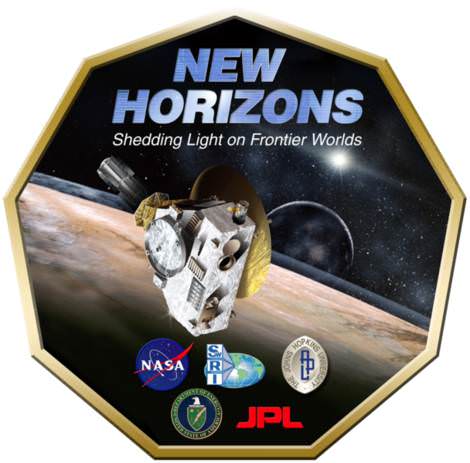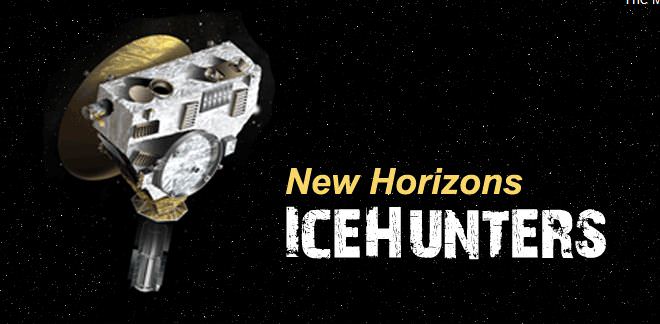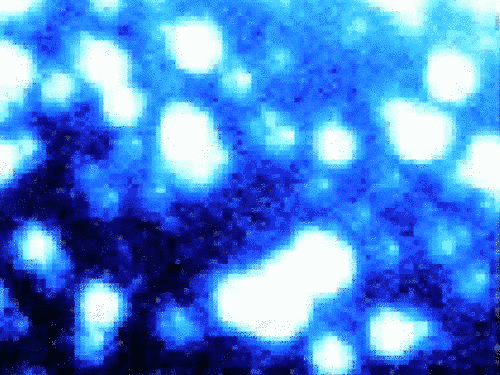
Citizen Scientists: Discover a New Horizons Flyby Target
NASA JHU APL | New Horizons | 2011 June 21
Help Scientists Decide on What KBOs the New Horizons Spacecraft Will VisitThe world is invited to help discover a potential new, icy follow-on destination for NASA’s New Horizons spacecraft, using the Ice Hunters website. New Horizons is currently en route to make the first flyby of the Pluto system, and is then capable of exploring additional bodies still farther out in the Kuiper Belt.
Through this citizen science project, the public can help scientists search through specially-obtained telescopic images for currently unknown objects in the Kuiper Belt. Along the way, they will also discover variable stars and asteroids. Ice Hunters is a Zooniverse citizen science project.
“The New Horizons project is breaking new ground in many ways,” says mission Principal Investigator Alan Stern, of the Southwest Research Institute. “We’re flying by a new kind of planet, we’ll be making the most distant encounters with planetary bodies in the history of space exploration, and now we’re employing citizen science to help find our potential extended mission flyby targets, perhaps a billion kilometers farther than even distant Pluto and its moons.
“We’re very excited to be working with Zooniverse and breaking this new kind of ground,” Stern says. “We hope the public will be excited to join in with us and with Zooniverse to make a little history of their own by discovering our next flyby target after Pluto.”
On the outer edges of the solar system an icy body lurks undiscovered, orbiting on a path that will just happen to carry it toward a potential rendezvous with the New Horizons spacecraft. This mission is on course for a 2015 flyby of Pluto, an encounter that begins New Horizons’ exploration of the Kuiper Belt. After visiting Pluto, the spacecraft will have enough fuel remaining to change its course to fly toward at least one and possibly two Kuiper Belt objects in the outer solar system – an object the Ice Hunters website is designed to find. The expected date of the KBO flyby will be between 2016 and 2020, depending on the object chosen and its distance from Pluto.
The Kuiper Belt, a region of the outer solar system extending past Neptune, contains small or “dwarf” planets; these are icy objects of a variety of sizes up to thousands of kilometers across. The first KBO other than Pluto was only discovered in 1992, and the KBO population is still not well mapped. Ice Hunters will do its part to study one small slice of the Kuiper Belt as it looks for an object along New Horizons’ trajectory after its Pluto flyby.
If that object can be found, it will become the most distant object ever visited by a spacecraft from Earth.
Using some of the largest telescopes in the world, scientists have imaged that region, producing millions of pictures that could contain images of the rare objects that are orbiting toward just the right location, along with many other small worlds on different trajectories. Ice Hunters users will be charged with marking these moving targets for follow-up examination.
The images contained in IceHunters.org are “difference” images, created by subtracting observations taken at two different times. By subtracting the two images, scientists can mostly (but not entirely) remove the light from constant sources like stars and galaxies. Left behind are the things that move or vary in brightness: Kuiper Belt objects, asteroids, and variable stars. Since the stars never subtract off perfectly, the images appear messy, and computers can’t be trained to find objects as effectively as a people can.
The search team will use the millions of mouse clicks made by Ice Hunters users to identify objects moving on orbits that New Horizons might reach. "When you're looking for something special in masses of messy, real-world data, sometimes there's no substitute for the human eye, and Zooniverse Ice Hunters will put thousands of eyes to work on this important job,” says John Spencer, of Southwest Research Institute, a member of the New Horizons science team who is coordinating the search effort.
New Horizons launched in January 2006, and is the first NASA New Frontiers mission. It tested its instruments during a 2007 flyby of the planet Jupiter, and scientists now eagerly await its July 2015 flight through the Pluto system. With this encounter, the U.S. becomes the first nation to visit all of the classical planets. If approved by NASA, the extended New Horizons journey to one or more other (and far, far smaller) targets in the Kuiper Belt will allow scientists, for the first time, to study up close the diversity of characteristics seen among Kuiper Belt objects.
The Ice Hunters project was produced at Southern Ilinois University Edwardsville as part of the Zooniverse, a collection of websites administered by the Citizen Science Alliance. More than 400,000 Zooniverse volunteers are already making important contributions to such diverse topics as the classification of galaxies in Hubble images, reconstruction of historical records of Earth's weather, and analysis of close-up pictures of the moon's surface. The public is invited to become a part of this and all other Zooniverse projects at Zooniverse.org.
Universe Today | Nancy Atkinson | 2011 June 21
Find cold, distant worlds with Ice HuntersHow would you like to help choose an additional destination or two for a spacecraft heading to the outer solar system? A new citizen science project from the Zooniverse — called Ice Hunters — will allow the public to help discover a potential new, icy follow-on destination for NASA’s New Horizons spacecraft, which is currently en route to make the first flyby of the Pluto system. However, after it zooms past Pluto, the spacecraft will have the capability to explore other Kuiper Belt Objects. But, the destination has yet to be chosen. That’s where you can help.
“Projects like this make the public part of modern space exploration,” said Dr. Pamela Gay. “The New Horizon’s mission was launched knowing we’d have to discover the object it would visit after Pluto. Now is the time to make that discovery and thanks to IceHunters, anyone can be that discoverer.”
With Ice Hunters, the public can help scientists search through specially-obtained deep telescopic images for currently unknown objects in the Kuiper Belt. While the images you’ll be perusing in Ice Hunters won’t be the beautiful astronomical images seen in the Galaxy Zoo classification of galaxies or the Moon Zoo images of the Moon, the science rewards in Ice Hunters will be spectacular.
And there’s more: there’s also the potential for discovering variable stars and asteroids.
What’s cool is that you’ll be searching for KBO’s and potential dwarf planets in much the same way that Clyde Tombaugh found Pluto: comparing images of the same region of the Kuiper Belt and looking for objects that move or vary in brightness.
“The New Horizons project is breaking new ground in many ways,” said New Horizons Principal Investigator Alan Stern. “We’re flying by a new kind of planet and we’ll be making the most distant encounters with planetary bodies in the history of space exploration, and now we’re employing citizen science to help find our potential extended mission flyby targets, perhaps a billion kilometers farther than even distant Pluto and its moons. We’re very excited to be working with Zooniverse and breaking this new kind of ground. We hope the public will be excited to join in with us and with Zooniverse to make a little history of their own by discovering our next flyby target after Pluto.”
Somewhere, on the outer edges of the solar system an icy body lurks undiscovered, orbiting on a path that will just happen to carry it toward a potential rendezvous with the New Horizons spacecraft.
New Horizons will flyby Pluto in 2015, and there will be enough gas in the spacecraft’s tank to fly toward at least one and possibly two Kuiper Belt Objects in the distant outer solar system. The expected date of the KBO flyby will be between 2016 and 2020, depending on the object chosen and its distance from Pluto.
Your mission, should you chose to accept, is to find the most interesting KBO possible for New Horizons to visit. If that object can be found , it will become the most distant object ever visited by a spacecraft from Earth.
The Kuiper Belt is a region of the outer solar system, extending past Neptune, (from 30AU) out to nearly twice Neptune’s orbit (out to roughly 55AU), which contains icy bodies in a variety of different sizes up to thousands of kilometers across. The first KBO other than Pluto was only discovered in 1992, and the KBO population is still not well mapped. Ice Hunters will do its part to study one small slice of the Kuiper Belt as it looks for an object along New Horizon’s trajectory after its Pluto flyby.
Using some of the largest telescopes in the world, scientists have imaged that region, producing millions of pictures for that could contain images of the rare objects that are orbiting toward just the right location, along with many other small worlds on different trajectories.
In “difference” images, which are created by subtracting observations taken at two different times, scientists can mostly (but not entirely) remove the light from constant sources like stars and galaxies. Left behind are the things that move or vary in brightness, which is what the users of IceHunters will be looking for. Since the stars never subtract off perfectly, the images appear messy, and computers can’t be trained to find objects as effectively as a people can.
“When you’re looking for something special in masses of messy, real-world data, sometimes there’s no substitute for the human eye, and Zooniverse Ice Hunters will put thousands of eyes to work on this important job,” said John Spencer of Southwest Research Institute, a member of the New Horizons science team who is coordinating the search effort.
Just as other Zooniverse projects have easy-to-use websites, IceHunters.org is no different. “Using just about any modern web-browser, users can circle potential KBOs and mark with a star the locations of asteroids,” said web developer Cory Lehan from Southern Illinois University Edwardsville, who has participated in several Zooniverse web designs. “The website is filled with examples to help get people started. Anyone should be able to take part – No Flash required.”
So check out Ice Hunters and start discovering today!
Discover Blogs | Bad Astronomy | 2011 June 21
The most exciting citizen science project everIn July 2015, the New Horizons probe will fly past Pluto, snapping pictures and taking data of this icy world. Whether you think Pluto is a planet or not* it’s still a fascinating object and I can’t wait to see what New Horizons sends back.
But what happens after that? The space probe will still be traveling into deep space at high speed… but space out there isn’t empty. Beyond Pluto lie the solar system’s coldest denizens, the Kuiper Belt Objects. These are lumps of ice, frozen chunks that may take millennia to circle the Sun once. We’ve identified over a thousand of these KBOs, and there are tens of thousands more waiting to be discovered. Scientists with the New Horizons mission are hoping to find one near enough to the probe’s path to plan a flyby, so we can finally see one of these things up close.
And that’s where you come in!
A new website, Ice Hunters, has been put together to help you find potential KBOs for New Horizons to visit. It’s part of the Zooniverse; a citizen science project that gets people involved in real astronomy. In this case, you can examine images from the giant Magellan and Subaru telescopes to look for targets. It’s actually not terribly hard; here’s one image I looked at:
Basically, KBOs move over time, so two images are taken some time apart. One is digitally subtracted from the other, so stars tend to go away (though they don’t erase perfectly, leaving those ugly residuals). Any whitish blobs left are things that have changed between the two images: variable stars, asteroids, cosmic rays, and, hopefully, KBOs. When you find something you simply tag it by clicking it. A circle is placed around it, and the location is logged. You can see the object I found in the image above.
Humans are pretty good at this, while computers are easily confused by the messy residuals. But just to make sure every click is saved and compared to the work of other people. The more an object is clicked, the more likely it is to be something real and worth following up. The website explains how all this works.
That’s all there is to it! You have to register to do this (unless you’re already a Zooniverse member); it’s free and easy. And who knows? You may literally be the person who finds an icy world that will get a visit from New Horizons!
Planetary Society | Emily Lakdawalla | 2011 June 21
IceHunters.org: Probing for KBOsA guest blogger here recently rounded up the large number of participatory research projects that are collectively known as citizen science. I think these are all very cool and I encourage you to check them out but none of them has yet inspired me to spend my precious time as grunt labor on a gigantic collective project. Until now.
Icehunters is a new site from Zooniverse -- the same people who brought you Galaxy Zoo, Planet Hunters, Moon Zoo, Old Weather, and more -- and it tackles a really compelling research problem, namely,
What as-yet-undiscovered world (or worlds!) will New Horizons explore once it has zoomed beyond Pluto?
And guess what? You just might discover them. (If I don't find them first.)
To explain: New Horizons isn't just a mission to Pluto; since its conception as the "Pluto Kuiper Express" it's been planned to perform at least one more flyby of a much smaller object in the Kuiper belt after Pluto has receded in New Horizons' rear-view mirror. But no perfect target has been discovered yet (although there is now at least one candidate, 1994 JR1). In fact, they haven't even been looking, until very recently. The problem is that the region of space that Pluto has been passing through is very difficult to canvas for tiny, dim, slow-moving Kuiper belt objects, because it just so happens that Pluto is currently near the galactic center in our sky and therefore in front of a pretty dense field of stars.
So the New Horizons team waited as long as possible to begin the search, which reduced the region of densely-star-filled sky that they had to search. But the search has finally begun, and on moonless nights they are grabbing as many photos of the region as they can using two enormous telescopes, the 8-meter Subaru telescope on Mauna Kea and the 6.5-meter Magellan telescope in Chile.
They're gathering a lot of data, and the sooner they discover good targets, the better. That's where you (and I!) come in: we're all invited to join the hunt for New Horizons' Kuiper belt target in the Icehunters project. You'll have it much easier than Clyde Tombaugh did; the project has already taken care of processing sets of images to show you the difference between two views of the sky taken hours apart. Potential Kuiper belt objects show up as little white blobs, waiting for your mouse clicks.
The demo has been out for a while, and I find it very easy to use (as are all the Zooniverse projects), with a very helpful tutorial. As of this morning it's passed its demo stage and is ready for prime time. So everybody go to Icehunters and join in the search for a world that we may get to explore with the nimble New Horizons. Opportunities to discover an object and see it explored within your lifetime are vanishingly rare. As a bonus, while you are hunting Kuiper belt objects you may spot faster-moving, streaked-out asteroids that nobody else has spotted before.
You can help make New Horizons an even greater journey of discovery -- now go forth and discover new worlds!
Centauri Dreams | Paul Gilster | 2011 June 22
Icehunters: Crowdsourcing the Kuiper Belt
Sky & Telescope | Shweta Krishnan | 2011 June 24





